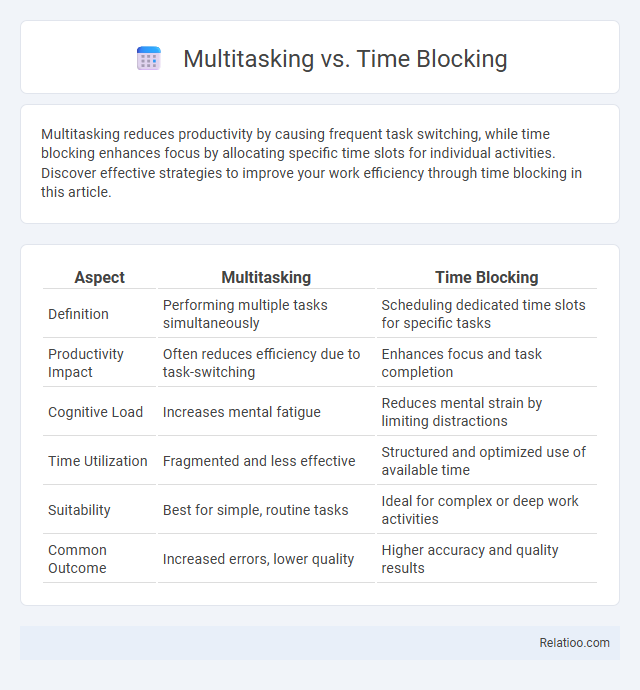Multitasking reduces productivity by causing frequent task switching, while time blocking enhances focus by allocating specific time slots for individual activities. Discover effective strategies to improve your work efficiency through time blocking in this article.
Table of Comparison
| Aspect | Multitasking | Time Blocking |
|---|---|---|
| Definition | Performing multiple tasks simultaneously | Scheduling dedicated time slots for specific tasks |
| Productivity Impact | Often reduces efficiency due to task-switching | Enhances focus and task completion |
| Cognitive Load | Increases mental fatigue | Reduces mental strain by limiting distractions |
| Time Utilization | Fragmented and less effective | Structured and optimized use of available time |
| Suitability | Best for simple, routine tasks | Ideal for complex or deep work activities |
| Common Outcome | Increased errors, lower quality | Higher accuracy and quality results |
Understanding Multitasking: Pros and Cons
Multitasking allows you to handle multiple tasks simultaneously, boosting short-term productivity but often leading to decreased focus and increased errors. While it can be effective for routine or simple activities, it may reduce the overall quality of complex work due to constant task-switching. Understanding your limits and the nature of your tasks is crucial to leveraging multitasking without compromising efficiency or accuracy.
The Concept of Time Blocking Explained
Time blocking involves dividing your day into specific segments dedicated to single tasks, maximizing productivity by reducing distractions and enhancing focus. Unlike multitasking, which splits your attention across multiple activities simultaneously and often decreases efficiency, time blocking encourages deep work on one task at a time. By adopting time blocking, you can better manage your schedule, minimize procrastination, and achieve more consistent results in Your daily workflow.
Productivity: Multitasking vs Time Blocking
Multitasking often reduces productivity by dividing Your attention across multiple tasks, leading to increased errors and longer completion times. Time blocking enhances productivity by allocating specific periods for focused work on single tasks, minimizing distractions and improving efficiency. Studies show that workers who use time blocking complete tasks faster and with higher quality compared to those who multitask.
Impact on Focus and Concentration
Time blocking enhances your focus by allocating specific periods to single tasks, minimizing distractions and improving concentration. Multitasking often fragments attention, leading to decreased productivity and increased errors due to frequent task switching. Prioritizing time blocking over multitasking optimizes mental clarity and sustained engagement throughout your workday.
Stress Management: Which Method Wins?
Time blocking helps reduce stress by allocating specific periods for focused work, minimizing distractions and preventing overload, while multitasking often increases stress due to task-switching and divided attention. Your ability to manage stress improves significantly when using time blocking, as it promotes mindfulness and better workload control. Research shows prioritizing single-task focus within scheduled blocks outperforms multitasking for maintaining mental clarity and reducing anxiety.
Real-World Applications and Examples
Multitasking often leads to reduced productivity due to divided attention, whereas time blocking allows you to allocate specific periods for focused tasks, enhancing efficiency and goal completion. In real-world applications, professionals using time blocking report better project management and stress reduction, while multitasking may cause errors, especially in complex or creative work. For example, software developers benefit from time blocking to maintain coding flow, whereas customer service agents might need multitasking to handle calls and data entry simultaneously.
Common Myths About Multitasking
Common myths about multitasking include the belief that it increases productivity and saves time, whereas studies show it often leads to decreased focus and lower quality of work. Time blocking is a more effective method, allocating specific periods for single tasks to enhance concentration and efficiency. Unlike multitasking, time blocking minimizes cognitive switching costs and reduces errors, improving overall task management.
Time Blocking: Tools and Techniques
Time blocking enhances productivity by allocating specific time slots for distinct tasks, reducing distractions and promoting focused work sessions. Essential tools for time blocking include digital calendars like Google Calendar and dedicated time management apps such as Todoist and Clockify, which enable users to visually organize and track their schedules. Techniques like the Pomodoro method integrate well with time blocking, segmenting work into manageable intervals to maintain high concentration and prevent burnout.
Choosing the Right Strategy for You
Choosing the right productivity strategy depends on your work style and task demands. Multitasking can help handle simple, quick tasks simultaneously, while time blocking enhances focus by dedicating specific periods to single tasks, reducing distractions. Assess your priorities and workflow to determine whether your productivity improves by splitting attention or concentrating deeply within scheduled blocks.
Final Thoughts: Striking a Balance
Striking a balance between multitasking and time blocking requires recognizing that multitasking can reduce productivity by fragmenting attention, while time blocking enhances focus by allocating specific time slots for tasks. Integrating flexible time blocks with short periods for managing quick, related interruptions optimizes efficiency and reduces cognitive overload. Prioritizing tasks based on urgency and complexity within a structured schedule ultimately fosters sustainable productivity and work-life balance.

Infographic: Multitasking vs Time Blocking
 relatioo.com
relatioo.com